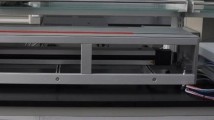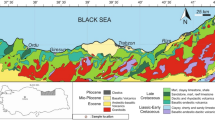Abstract
In this paper, an attempt has been made to predict the thermal conductivity (TC) of rocks by incorporating uniaxial compressive strength, density, porosity, and P-wave velocity using support vector machine (SVM). Training of the SVM network was carried out using 102 experimental data sets of various rocks, whereas 25 new data sets were used for the testing of the TC by SVM model. Multivariate regression analysis (MVRA) has also been carried out with same data sets that were used for the training of SVM model. SVM and MVRA results were compared based on coefficient of determination (CoD) and mean absolute error (MAE) between experimental and predicted values of TC. It was found that CoD between measured and predicted values of TC by SVM and MVRA was 0.994 and 0.918, respectively, whereas MAE was 0.0453 and 0.2085 for SVM and MVRA, respectively.





Similar content being viewed by others
References
Aurangzeb, Maqsood A (2007) Modeling of the effective thermal conductivity of consolidated porous media with different saturants: a test case of gabbro rocks. Int J Thermophys 28(4):1371–1386
Canakcı H, Demirboga R, Karakoc BM, Sirin O (2007) Thermal conductivity of limestone from Gaziantep (Turkey). Build Environ 42:1777–1782
Clauser C, Huenges E (1995) Thermal conductivity of rocks and minerals. In: Ahrens TJ (Ed) Rock physics and phase relations: a handbook of physical constants. American Geophysical Union, Washington, DC, pp 105–126
Cristianini N, Shawe-Taylor NJ (2000) An introduction to support vector machines. Cambridge University Press, Cambridge
Demirci A, Gorgulu K, Duruturk YS (2004) Thermal conductivity of rocks and its variation with uniaxial and triaxial stress. Int J Rock Mech Min Sci 41:1133–1138
Gorgulu K (2004) Determination of relationships between thermal conductivity and material properties of rocks. J Univ Sci Technol Beijing 11:297
Harmathy TZ (1970) Thermal properties of concrete at elevated temperatures. J Mater 5:47–74
Hasan A (1999) Optimising insulation thickness for buildings using life cycle cost. Appl Energy 63:115–124
Incropera FP, Dewitt DP (1990) Fundamentals of heat and mass transfer. Wiley, New York
John CP (1998) Sequential minimal optimization: a fast algorithm for training support vector machines, Technical report, MSR-TR-98-14
Khandelwal M (2010a) Prediction of thermal conductivity of rocks by soft computing, Int J Earth Sci (online published), doi:10.1007/s00531-010-0550-1
Khandelwal M (2010b) Evaluation and prediction of blast induced ground vibration using support vector machine. Int J Rock Mech Min Sci 47(3):509–516
Khandelwal M (2010c) Blast-induced ground vibration prediction using support vector machine, Engineering with Computers (online published). doi:10.1007/s00366-010-0190-x
Khandelwal M, Kankar PK (2009) Prediction of blast-induced air overpressure using support vector machine. Arab J Geosci (online published). doi:10.1007/s12517-009-0092-7
Muller KR, Smola JA, Scholkopf B (1997) Prediction time series with support vector machines. In: Proceedings of international conference artificial neural networks, Lausanne, Switzerland, pp 999–1004
Ozkahraman HT, Selver R, Isik EC (2004) Determination of the thermal conductivity of rock from P-wave velocity. Int J Rock Mech Min Sci 41:703–708
Schmidt M (1996) Identifying speaker with support vector networks. In: Interface, ‘96 Proceedings, Sydney
Scholkopf B, Burges C, Vapnik V (1995) Extracting support data for a given task. In: Proceedings of first international conference knowledge discovery and data mining. AAAI Press, Menlo Park
Singh TN, Sinha S, Singh VK (2007) Prediction of thermal conductivity of rock through physico-mechanical properties. Build Environ 42:146–155
Troschke B, Burkhardt H (1998) Thermal conductivity models for two-phase systems. Phys Chem Earth 23(3):351–355
Vapnik VN (1998) Statistical learning theory. Wiley, New York
Verma BP (2000) Rock mechanics for engineers. Khanna Publishers, New Delhi, p 108
Witten IH, Frank E (2005) Data mining: practical machine learning tools and techniques, 2nd edn. Morgan Kaufmann, San Francisco
Yasar E, Erdogan Y (2008) Strength and thermal conductivity in lightweight building materials. Bull Eng Geol Environ 67:513–519
Yasar E, Erdogan Y, Guneyli H (2008) Determination of thermal conductivity from physico-mechanical properties. Bull Eng Geol Environ 67:219–225
Author information
Authors and Affiliations
Corresponding author
Rights and permissions
About this article
Cite this article
Khandelwal, M. Application of an expert system to predict thermal conductivity of rocks. Neural Comput & Applic 21, 1341–1347 (2012). https://doi.org/10.1007/s00521-011-0573-y
Received:
Accepted:
Published:
Issue Date:
DOI: https://doi.org/10.1007/s00521-011-0573-y




